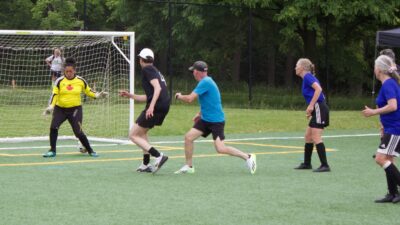‘Biggest sport no one’s heard of:’ Walking soccer gains ground in Canada
By Canadian Press on July 23, 2025.

TORONTO — Kerrin Hands calls walking soccer “the biggest sport no one’s heard of.”
Hands, who runs the Toronto Walking Soccer Club, was initially skeptical about the appeal of a no-running version of the world’s most popular game. But it didn’t take long for the game to win him over.
“The game is pretty engaging. When I first heard of it and I went to play for the first time, I had my doubts, walking through it didn’t sound that exciting,” Hands said. “But within 10 minutes, I totally understood it.
“You have to be able to pass well, you have to move into position well because you’ve got to make up for the fact that you can’t run. So I think that’s almost like a game of chess. You really are tactical, and the passing has to be quick.”
Hands has organized what’s being billed as North America’s first-ever women’s international walking soccer tournament, set for Thursday at the Pickering Soccer Centre in Pickering, Ont. Four teams — including his own Toronto Loons — will take part, featuring players from Canada and the British Isles.
Among them is the Celtic Nations Women’s Walking Football team, travelling from overseas for what Hands calls “the largest gathering of women to play in a walking soccer event on the continent.”
The sport was created in 2011 in England by John Crute, the chairman of Chesterfield Football Club. According to a release, there are now 200,000 players in England, and there are 20 clubs in Canada, from Vancouver Island to Halifax.
Clubs also exist in Australia, New Zealand, France, Rwanda, Nigeria, Thailand, Singapore and Spain, which will host the World Nations Cup in October.
Hands says what makes the sport intriguing is that players can continue well into their senior years.
“Running soccer, it’s pretty robust and as you get older, you don’t want to get injuries and it slows you down for an entire day after having played,” he said. “I think that puts a lot of people off playing soccer. So when walking soccer is introduced, the rules make sure that the competitors are safe.”
It’s also easy to pick up, says 64-year-old Elisabeth Peters, who plays in Hands’ recreational club. She took up the sport with her husband, Alejandro, as a way to get active and try something new after seeing others play.
“You don’t need to know how to play soccer because the rules are a bit different, and so you quickly adapt and you are part of the game,” she said. “We have three touches, we cannot touch the ball more than three times (in succession).
“People have to share the ball. It cannot be just one person who goes from one side of the field to the other one … This way, you can learn how to play soccer, even if you never play in your life.”
The rules don’t allow for tackling from behind or from the side, only from the front. The ball must stay below the bar height or head height, eliminating headers.
If the ball goes out for a goal kick, goalkeepers can bring it back into play using their hands or feet, allowing them to roll it in if they wish. In addition, only the goalkeeper is allowed inside the semicircular area around the goal. If an attacking player enters the area, possession is awarded to the goalkeeper. If a defender steps in, the opposing team is given a penalty.
If a team commits four non-walking penalties, the opponent is awarded a penalty kick.
However, Hands did acknowledge that rules can differ in other parts of the world.
“I believe in Germany, they don’t have goalkeepers, for example,” he said. “And UEFA has just brought out their own rules, but they’re very loose, a bit contentious right now, but I think it’s their first attempt at trying to grow walking soccer as well.”
This report by The Canadian Press was first published July 23, 2025.
Abdulhamid Ibrahim, The Canadian Press
-22




